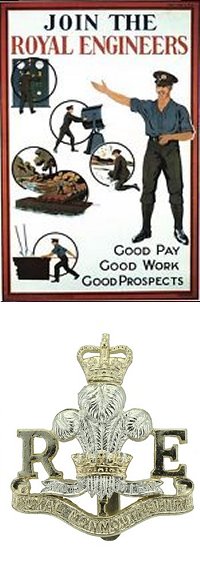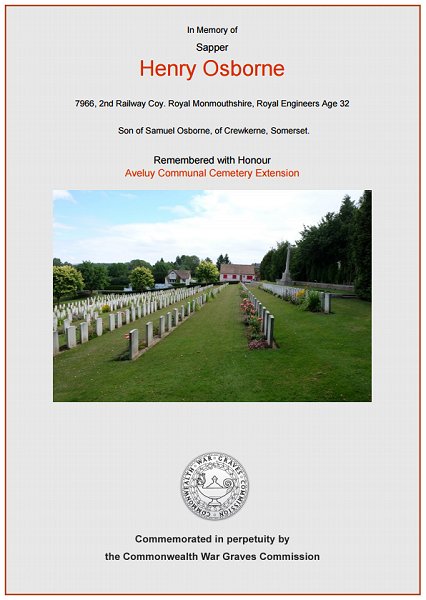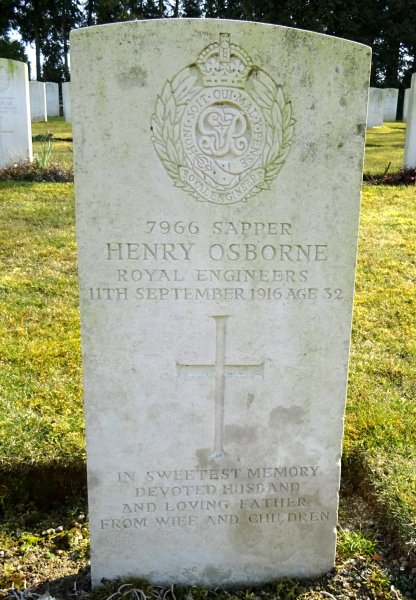yeovil at War
Henry Osborne
Killed on active service during the Somme Offensive
Unfortunately almost nothing is known of Henry Osborne. He was born in Yeovil in 1884, the son of Samuel Osborne (b1856, Crewkerne) and his wife Elizabeth, but it seems that Samuel was a professional soldier which probably accounts for the lack of information concerning Henry in civil records. Although born in Yeovil it is unlikely that Henry lived here for very long, his parents residence (at the time of Henry's death) being in Crewkerne. Henry was married and had children but no details are known.
 Henry
is known to have
enlisted in
Monmouthshire,
joining the 2nd
Railway Company,
of the Royal
Monmouthshire
Royal Engineers
(Militia) as a
Sapper. His
Service Number
was 7966,
suggesting he
enlisted in 1915.
Henry
is known to have
enlisted in
Monmouthshire,
joining the 2nd
Railway Company,
of the Royal
Monmouthshire
Royal Engineers
(Militia) as a
Sapper. His
Service Number
was 7966,
suggesting he
enlisted in 1915.
The (R MON RE(M)) is the most senior regiment in the British Army Reserve, having given continuous loyal service to the crown since 1539. It is part of the reserve forces, and today is the only remaining Militia unit in the British Army. The R Mon RE(M) is the only unit to have two 'Royal' prefixes in its title.
The Royal Monmouthshire Royal Engineers (Militia) became a unit of the newly-created Special Reserve in 1908. As such, the Regiment was available for service overseas should it be needed, and it was mobilised in August 1914 on the outbreak of the First World War. At this point, the Regiment consisted of three companies; in November 1914, all three were sent to France and Flanders where they served in various locations until the end of the war.
Between September 1914 and January 1917 five further companies were formed from new volunteers. Four of these were sent to France, but one (No 5 (Siege) Company) was sent to Gallipoli and Egypt.
The 2nd Railway Company, of which Henry was a member, was a 'Special Reserve RE Railway Company' and comprised ten officers and 290 men. On 11 November 1914 the Company landed in France, although Henry, of course, was yet to join them.
After the realisation that the war would not be over by Christmas, the British Army set in motion plans to expand upon the remaining rail network still in Allied hands in France and Flanders. It was soon seen that these units would not suffice for probable requirements and the Director of Railway Transport was instructed to organise additional Railway Construction units. In October 1914, the Railway Executive Committee in England formed a Sub-Committee for Recruiting. Very large numbers of the employees of British railway companies were then volunteering for military service and the men for RE Railway units were selected from them. By the end of 1917, out of 180,000 enlistments from English railway companies, about 40,000 were serving in RE Railway units.
Once in France, the sappers would be assigned to a Construction Train, of which there were eight in operation in mid-1915. Each Construction Train would have a complement of up to two complete Railway Companies, with a Captain as officer commanding the train. This enabled the sappers to carry both themselves and all their necessary tools and equipment to and from wherever the next work was required. The Companies would pitch tents for accommodation, as required. Large-scale work would include the construction of the major stores and ammunition dump at Audruicq, ten miles from Calais. Here, and at numerous other locations such as the nearby major ammunition dump at Zeneghem Yard, there was great use of Chinese Labour and R.E. Labour Companies to prepare the ground, ready for the platelaying sappers.
As the various campaigns and battles unfolded, RE Railway Companies were engaged all over the British sector, joined by Dominion RE Railway Companies. Close examination of the period maps bear testimony to miles of what was to be temporary track that criss-crossed the area. Howitzer Spurs, Ambulance Train Sidings, Tank Enablements and bridges were all constructed, in addition to the constant maintenance and line doubling. Work in progress was always a potential target for enemy artillery and also there were the attentions of the German Air Force to contend with. Zeneghem Yard, for instance, was a natural target and sappers from RE Railway Companies are recorded as having to help extinguish serious fires resulting from air raids.
A primary objective was always to take standard gauge railways as close to the front as possible, to lessen the demands on light railway systems, horsed transport and manpower. For the sappers, work could mean toiling around the clock, especially where lines had been cut by shellfire. Inevitably there were casualties; analysis of the records shows that 173 men from Railway Companies lost their lives. This included Henry Osborne who, while on the battlefields of the Somme, was killed in action on 11 September 1916. He was 32 years old.
Henry Osborne was buried at the Aveluy Communal Cemetery Extension, Somme, France, Grave J39. His name was added to the War Memorial in the Borough in 2018.
gallery

The Commonwealth War Graves Commission certificate in memory of Henry Osborne.

Henry Osborne's CWGC headstone.